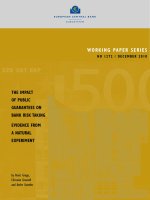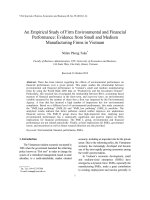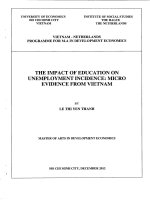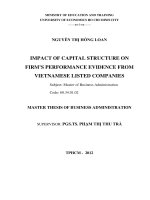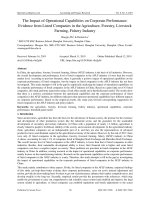Impact of ownership structure on financial performance of banks: The impact of capital structure on firm’s performance evidence from Saudi Arabia
Bạn đang xem bản rút gọn của tài liệu. Xem và tải ngay bản đầy đủ của tài liệu tại đây (130.94 KB, 11 trang )
Journal of Applied Finance & Banking, vol. 4, no. 2, 2014, 183-193
ISSN: 1792-6580 (print version), 1792-6599 (online)
Scienpress Ltd, 2014
The Impact of Capital Structure on Firm’s Performance
Evidence from Saudi Arabia
Abdullah Ewayed M. Twairesh 1
0F
Abstract
The purpose of this paper is to empirically investigate the impact of capital structure on
the performance of non-financial firms operating in Saudi Arabia as one of emerging or
transition economies. Panel econometric technique called fixed effect regression is used
for the period between 2004 and 2012.Sample data includes 74 companies. The study
analyzes the relationship between capital structure proxies that include short-term debt
(STD), long-term debt (LTD) and total debt (TD) and the operating performance
measured by return on assets (ROA) and return on equity (ROE). The firm’s size that was
found in the literature to have an influence on the performance of a firm is used as a
control variable. The study finds that STD, LTD and TD have significant impacts on
ROA. While only LTD has significant impacts on ROE. Firm size has significant impacts
on firm performance when ROA is a dependent variable and no impact on firm
performance when ROA is dependent variable.
JEL classification numbers:
Keywords: Capital structure, Firm performance, Return on Asset, Return on equity,
Saudi Arabia
1 Introduction
Capital structure decisions are among the most significant finance decisions companies
encounter. It has been long debated whether capital structures are influential on costs of
capital and firm values. The theory of capital structure and its relationship with a firm’s
value and performance has been a puzzling issue in corporate finance and accounting
literature since the Modigliani and Miller (1958) argue that under the perfect capital
market assumption that, if there is no bankrupt cost and capital markets are frictionless, if
1
University of Tabuk .Department of Finance and Investment, College of Business Administration,
Saudi Arabia.
Article Info: Received : December 30, 2013. Revised : February 5, 2014.
Published online : March 1, 2014
184
Abdullah Ewayed M. Twairesh
without taxes, the firm’s value is independent with the structure of the capital. Debt can
reduce the tax to pay, so the best capital structure of enterprises should be one hundred
percent of the debt. Since then, several theories have been developed to explain the capital
structure of a firm including the Pecking Order Theory, Static Tradeoff theory, and the
Agency Cost theory. The firm’s decision about its source of capital will affect its
competitiveness among its peers. Therefore, a firm should use the appropriate mix of debt
and equity that will maximize its profitability.
The lack of consensus among the theories that try to explain the capital structure of a firm
has led to many empirical studies in this topic. These studies are trying to reach a
conclusion about the impact of capital structure on firms’ performance. While the
literature examining the performance implications of capital structure choices is immense
in developed markets (e.g. USA and Europe), little is empirically known about such
implications in emerging or transition economies such as Saudi Arabia t. In such a
country as Eldomiaty (2007) argued, capital market is less efficient and incomplete and
suffers from higher level of information asymmetry more than capital markets in
developed countries. This environment of the market may cause financing decisions to be
incomplete and subject to a considerable degree of irregularity. It is, therefore, necessary
to examine the validity of corporate leverage levels impact on firms’ performance in
Saudi Arabia as an example of emerging economies. To this researcher's knowledge, no
such study has been carried out on the Saudi Arabia market
This paper aims to empirically investigate the impact of the capital structure decision on
firms’ financial performance for firms that operate in Saudi Arabia and are listed on the
capital market during the period 2004-2012. In the case of Gulf Cooperation Council
(GCC) countries in general and Saudi Arabia in particular, companies operate in a quite
unique environment. For instance, there are no personal taxes, relatively low corporate
taxes and companies have less financial constraints than their counterparts in other
emerging markets Al-Malkawi et al. (2013). Moreover, emerging markets including Saudi
Arabia are usually characterized by concentrated ownership and financial systems that are
bank rather than market-based. In this case, banks can play an important role in closing
the information gap between firms’ management and the market.
This study differs from previous studies as it was not limited to specific sectors in Saudi
Arabia and do not cover a limited number of firms only. Besides, this study utilizes a new
approach in the analysis by using panel data regression analysis (based on balanced panel
data set with fixed effect model) to find impact of the capital structure decision on firms’
financial performance. Lastly a more recent data set covering the 2004 to 2012 period is
used, thus allowing for a more relevant and up-to-date findings.
2 Literature Review
A number of studies exist in the finance literature concerning the relationship between
capital structure and firm performance. Modigliani and Miller (1958) reached the
conclusion that firm value and capital structure are independent of one another in the
studies conducted on the assumption that capital markets are perfect. This seems to be
unreasonable in the real world, which led many researchers to introduce additional
rationalization for this proposition and its underlying assumptions showing that capital
structure affects firms’ value and performance.
Impact of Capital Structure on Firm’s Performance: Evidence from Saudi Arabia
185
Toraman et, al. (2013) investigate the effects of capital structure decisions on firms’
profitability in manufacturing sector in Turkey. The data used correspond to the financial
statements of manufacturing companies for the period of 2005 and 2011. Regression
analysis was employed by using financial ratios obtained from financial statements of
firms within the scope of analysis. Results showed that short term liabilities to total assets
and long term liabilities to total assets have a negative relationship with the ROA as
performance indicator. There is positive relationship between operating income to
financial expenditures and financial performance
Chinaemerem & Anthony (2012) investigated the impact of capital structure on financial
performance of Nigerian firms using a sample of thirty non-financial firms listed on the
Nigerian Stock Exchange. The study used debt to equity ratio as financial leverage
indicator and return on asset, (ROA), return on equity, (ROE) as performance indicators.
The result shows that a firm’s capital structure has a significantly negative impact on the
firm’s financial performance. The finding of this study Indicate consistency with prior
empirical studies and provide evidence in support of Agency cost theory
Muritala (2012) examines the optimum level of capital structure through which a firm can
increase its financial performance using annual data of ten firms spanning a five-year
period. The results from Panel Least Square (PLS) confirm that asset turnover, size,
firm’s age and firm’s asset tangibility are positively related to a firm’s performance, a
negative put significant relationship between asset tangibility and ROA as a measure of
performance.
Thaddeus and Chigbu (2012) analyze the effect of leverage financing on corporate
performance using debt-equity, coverage ratios and earnings per share in the Nigerian
banking industry. Results across the banks studied show mixed outcome, and leverage
financing was established as critical strategy for maximization of shareholders returns.
The conclusion therefore is that in order to ensure that leverage financing leads to desired
outcome business, organizations must establish their optimum level as well as strike a
strategic balance with associated financing risk and returns to owners of the firm.
Salim and Yadav (2012), who used ROA, ROE, EPS and Tobin’s Q variables to measure
firm performance, conducted their study on 237 Malaysian companies listed in Bursa
Malaysia Stock Exchange. Obtained findings displayed a negative correlation between
ROA, ROE, EPS and LTD, STD and total debts. However, the findings put forward a
positive correlation between Tobin’s Q and LTD, STD.
Soumadi & Hayajneh (2011) investigated the effect of capital structure on the
performance of the public Jordanian firms listed in Amman stock market. Study results
revealed that capital structure is associated negatively put statistically with firm
performance. In addition, the study found out that there was no significant difference to
the impact of the financial leverage between high financial leverage firms and low
financial leverage firms on their performance.
Sunday Ojo (2011) examines the effect of financial leverage on corporate performance in
Nigeria. Econometric technique of Vector Auto Regression (VAR) model was employed.
Results revealed that Leverage shocks exert substantially on corporate performance in
Nigeria. In addition, Earnings per Share (EPS) depend more on feedback shock and less
on leverage shock. Leverage shocks on Earnings per Share indirectly affect the Net Assets
per Share of firms as the bulk of the shocks on the Net Assets per Share were received
from Earnings per Share of the firms.
Ebaid (2009) investigates the impact of capital structure choice on performance of 64
firms from 1997 to 2005 in the Egyptian capital market. He employs three
186
Abdullah Ewayed M. Twairesh
accounting-based measures; including ROA, ROE and gross profit margin, and concludes
capital structure choices, generally, have a weak-to-no impact on firm performance.
Tsung Cheng (2009) studied the relative effects of debt and equity financing on the
operating performance. Findings of this study show that apart from high cash flow firm,
debt finance and debt financing have significantly negative consequence for operating
performance. Hence, these findings suggest that it is dangerous for firms to rely or depend
entirely on either debt or equity for raising capital but it is much safer and better to raise
finance by both methods. Thus, these findings encourage firms to try whenever possible
to raise finance by using both methods simultaneously, with the advantages of the one
method offsetting the difficulties of the other and vice versa.
Razak. and Aliahmed, (2008) examines the impact of an alternative ownership control
structure of corporate governance on firm performance among government linked
companied (GLCs) and Non –GLC in Malaysia, The study was based on a sample of 210
firms over a period from 1995 to 2005. Findings reveal that there is a significant impact
of government ownership on company performance after controlling for company specific
characteristics such as company size, non- duality, leverage and growth. The finding is of
significance for investors and policy marketers which will serve as a guide for better
investment decisions.
Abor (2005) noted that various capital structure measures which represented short term
debt, long term debt and total debt associated negatively and statistically with firm
performance. The conclusion shows that firms rely mainly on borrowing, which will not
achieve tax shields and then it leads to an increase of borrowing cost which exposes the
firm to bankruptcy risks and reduces the return.
To sum up, empirical studies regarding the relationship between capital structure and
firm’s performance in developed countries provided mixed and contradictory evidence;
on the other hand there are a few studies which empirically examine this relationship in
emerging economies. The present study extends the literature on the impact of capital
structure on firm’s performance by empirically examining the relationship between
capital structure and firm’s performance in Saudi Arabia
3 3 Research Methodology
3.1 Data and Sample
The main objective of this study is to examine the impact of leverage on firm’s financial
performance in Saudi Arabia using data over 2004 and 2012. The data was hand collected
and the choice of the companies was based on the availability of data. The number of
companies included in our analysis is 79. The analysis is based on balanced panel data
with 711 firm-year observations (79 firm's × 9 years) the banks and the financial
institutions were excluded from the sample because of their specific financial activities
and their supervision under the central bank.
3.2 Statistical Techniques
In this study a panel data regression analysis is performed, panel data is a combination of
cross section and time series data. A panel data approach is more useful than either
cross-section or time-series data alone. There are many benefits of using panel data:
Impact of Capital Structure on Firm’s Performance: Evidence from Saudi Arabia
187
Controlling individual heterogeneity; giving more useful data, more variability, less
collinearity among the variables, more degrees of freedom and more efficiency. While
Time- series is plagued with multicollinearity; panel data has the ability to identify and
measure effects that are simply not noticeable in pure cross-section or pure time-series
data; It also allows us to build and test more complex behavioral models than pure
cross-section and time series data; Panel data are usually gathered on micro units, like
individuals, firms and households. Many variables can be more accurately measured at
the micro level, and biases resulting from aggregation over firms or individuals are
eliminated (Baltagi, 2005).
In this paper, the study estimates the fixed-effects model. The term fixed effects are due
to the fact that the intercept varies over firms, but it is constant over time. So, it is time
invariant. The slope or coefficients of the regressors do not also vary over time (Gujarati
2003). This study tries to explore the impact of the independent variables on dependent
variable values over time using the following models:
Y it = αi + βi X it + U it
Where Y represents the dependent variable (return on assets (ROA), return on equity
(ROE)). i firm, t time; αi is the individual effect that can be decomposed into fixed
individual effect. X is a vector of explanatory variables: leverage, liquidity, tangibility,
size and expectation growth, 1 β parameters, and u is a random unobserved component
that reflects unobserved shocks affecting the performance of firms.
3.3 Variable Description and Hypotheses
The purpose of this paper is to empirically investigate the impact of capital structure on
firms’ financial performance for firms that operate in Saudi Arabia.
3.3.1 Dependent variables
3.3.1.1 Performance
There are numerous studies that reviewed the effect of leverage on corporate
performance. In these studies performance is reflected in accounting indicators, such as
return on assets and return on equity (among others are Zeitun and Tian, 2007; Ebaid,
2009; Saeedi and Mahmoodi, 2011; San and Teh, 2011). Also, gross and profit margins
are applied in some of these studies. These measures reflect profitability, as well as
financial performance of the company. However, if a firm is profitable, it does not mean
that cash flows available to this firm will cover all its liabilities and at least creditors will
be paid. .In this study, two accounting based measures of performance were used. The
first measure is the return on assets (ROA) which is calculated by taking the ratio of net
profit of the firm to the total assets of the firm. The second measure is return on equity
(ROE) which is calculated by taking the ratio of net profit of the firm to total equity
ROA; the return on assets is calculated by dividing net income with total assets
ROE; return on equity is another profitability ratio that is defined by dividing net income
by equity ROA
188
Abdullah Ewayed M. Twairesh
3.3.2 Independent variable:
Leverage: financial leverage relates to long-term solvency ratios that “address the firm’s
long run ability to meet its obligations” (Hillier et al., 2010). Financial leverage is usually
determined by total debt ratio, and in empirical literature, it is measured by dividing book
value of total debt by a book value of total assets, Similar to previous literature (Abor,
2005; Abor, 2007, Ebaid, 2009), financial leverage was measured in the study by three
ratios, These measures are the ratio of short-term debt to total assets (STD), the ratio of
long-term debt to total assets (LTD) and total debt to total assets (TD).
The following hypothesis will be tested:
There is a negative relationship between financial leverage and a firm’s performance.
Firm size: The size of a firm is considered to be an important determinant of a firm’s
profitability; hence the size of the firm, which is measured by the logarithm of total
assets, could influence its financial performance. Prior research suggests that firm’s size
may influence its performance, larger firms have a greater variety of capabilities and can
enjoy economies of scale, which may influence the results and the inferences, so firm
size is considered as a control variable in the model (Ramaswamy, 2001; Frank & Goyal,
2003; Jermias, 2008 ,Onaolapo and Kajola(2010) . The following hypothesis will be
tested
There is a negative relationship between firm’s size and firm’s performance
3.4 The Econometric Model
Based on the research hypotheses developed above, the general empirical model to be
estimated using the panel data analysis, for firm i in period can be written as:
ROAi,t = β0 + β1 STDi,t + β 2 LTDi,t + β 3 TDi,t + β 4 SIZEi,t + μi,t…………...………(1)
ROEi,t = β0 + β1 STDi,t + β 2 LTDi,t + β 3 TDi,t + β 4 SIZEi,t + μi,t…………...………(2)
Where:
ROAi,t = return on total assets for firm I in year t
ROEi,t = return on total equity for firm I in year t
STDi,t = short-term debt to total assets for firm I in year t.
LTDi,t = long-term debt to total assets for firm I in year t.
TTDi,t = total debt to total assets for firm I in year t.
Log SIZEI, t = logarithm of total assets for firm I in year t.
μi,t = the error term.
4 Results and Discussion
4.1 Descriptive Statistics
Descriptive statistics for dependent and independent variables of the study are tabulated
below in Table 1. From the table, it is clear that all the variables have positive means.
Statistics for capital structure proxies (i.e. STD, LTD and TD) show means of 20.59, 8.13
Impact of Capital Structure on Firm’s Performance: Evidence from Saudi Arabia
189
and 28.11 percent for short-term, long-term and total debts, respectively, which indicates
that Saudi firms do not employ high levels of debt in order to raise capital. Furthermore,
Saudi firms on average use long-term debt as a means of capital financing more than
short-term loans. The means of 7.6, and 11.19 percent for ROA and ROE, respectively,
show that the performance of Saudi companies is poor during the study period from 2004
to 2012. Finally, the average size of 6.13 for the sample firms with minimum value of
4.72 and maximum of 8.52 indicates that most of the sample firms are close in terms of
size despite the fact that they are operating in different sectors.
Table 1: Descriptive statistic data
Mean
Median
Minimum
Maximum
Obs.
ROA
ROE
STD
LTD
TD
SIZE
702
702
702
702
702
702
0.075769
0.111979
0.205964
0.081392
0.281159
6.130762
0.062676
0.105889
0.157812
0.032564
0.234587
6.117782
-1.309683
-2.93745
0.001890
0.000000
0.001890
4.728248
0.524959
0.832923
1.334263
0.607179
1.334263
8.529474
Std. Dev.
0.113483
0.184995
0.167431
0.118573
0.194245
0.712709
Table 2 below shows the correlation matrix of the dependent and independent variables.
As shown in the table, the highest correlation coefficient between the LTD and SIZE is
(0.324). All the other correlation coefficients are less than 0.30 which means that there is
no multicollinearity problem. In addition, the results show that the STD, TD and SIZE are
positively correlated to profitability, while the LTD has negative correlations with
profitability.
ROA
ROE
STD
LTD
TD
SIZE
Table 2: Correlation Matrix for the variables
ROA
ROE
STD
LTD
1.000000
0.226744
1.000000
0.086288
0.115525
1.000000
-0.098806
-0.144968
-0.123551
1.000000
0.014202
0.097440
0.193414
0.259248
0.139023
0.193299
0.201488
0.323627
TD
1.000000
0.201488
4.2 Regression Results
The analysis on the impact of capital structure on firms’ performance is presented in the
tables 3a & 3b. Table 3a which present the results of fixed effect regression used in
testing the relationship between capital structure and firm’s performance. Table 3a
presents the results of testing the relationship between capital structure measured by ratio
of STD to total, ratio of LTD to total assets, ratio of TD to total assets, and firm’s
performance measured by ROA. As shown in this table, the results indicate a significant
negative relationship between STD and ROA; the coefficient of STD in model 1 is
negative and statistically significant at level 5 percent, which suggests that an increase in
STD is associated with a decrease in (ROA). Also the results indicate a significant
190
Abdullah Ewayed M. Twairesh
negative relationship between LTD and ROA; the coefficient of LTD in model 1 is
negative and statistically significant at level of 1 percent, which suggests that an increase
in associated with decrease in ROA. This may be due to considerable amount of in capital
structure of Saudi Arabia firms is LTD. On the other hand, as shown in Table 3a, TD has
significant relationship with ROA; the coefficient of LTD indicates a significant negative
relationship between LTD and ROA. These findings are consistent with the previous
results found by Ebaid (2009) who reported that only STD and TD of capital structure
proxies have significant relation with firms’ performance measured by ROA. Finally, the
results show that firms’ performance (ROA) has significant relationship with control
variable (firm size).
Table 3a: Panel least square regression result (Dpt – ROA)
Ind. Variable
Coefficient
t-Statistic
C
STD
LTD
TD
SIZE
R-squared
Adjusted R-squared
F-statistic
Hussmann test
0.446417
-0.074821
-0.180765
-0.140352
0.037872
0.831
0.893
6.587709
(0.000)
18.317582
0.0011
4.219121
-1.962613
-5.378711
-2.434859
-2.150907
Prob.
0.0000
0.0401
0.0022
0.0018
0.0319
Table 3b presents the results of testing the relationship between capital structure measured
by ratio of STD to total assets Model 2, ratio of LTD to total assets Model 2, ratio of TD
total debt to total assets Model 2, and firm’s performance measured by ROE. As shown in
this table, the results indicate that neither STD nor TD, has a significant relationship with
firm’s performance measured by ROE; These findings are consistent with the results
reported by Saeedi and Mahmoodi (2011) and Ebaid (2009) who found no evidence of a
significant relationship between ROE and capital structure, these findings contradict with
those reported by Ahmad, et al (2012), who found a significant positive relationship
between all capital structure proxies and ROE, ratio of LTD to total assets has a
significant relationship with firm’s performance measured by ROE at 10 percent. The
results also indicate that the control variable (firm size) has no significant effect on firm’s
performance,
Impact of Capital Structure on Firm’s Performance: Evidence from Saudi Arabia
191
Table 3b: Panel least square regression result (Dpt – ROE)
Ind. Variables
C
STD
LTD
TD
SIZE
R-squared
Adjusted R-squared
F-statistic
Hussmann test
Coefficient
t-Statistic
Prob.
0.446926
-0.145033
-0.359364
0.061332
-0.047803
0.451939
0.380337
6.311852
(0.000)
16.323872
(0.0026)
3.160717
-0.657694
-1.765967
0.337876
-1.423431
0.0017
0.5110
0.0779
0.7356
0.1551
5 Conclusions
Most of the studies above investigate these implications in the developed countries, very
little is empirically known about such implications in emerging or transition economies
such as Saudi Arabia. This research attempts to explore the relationship of capital
structure decisions with the firms performance of 74 Saudi Arabia firms listed on the
Saudi Arabia Stock Exchange (TADAWUL) for the period 2004-2012. The analysis is
performed by using panel econometric technique called fixed effect regression
While conducting this study, two indicator variables were used as a measure of firm's
performance (ROA and ROE) and three variables were used as proxies for capital
structure (STD, LTD and TD). Size was used as a control variable for firms. The study
finds that STD, LTD and TD have significant impact on ROA. While only LTD has a
significant impact on ROE. Firm size has significant impact on firms’ performance when
ROA is a dependent variable and no impact on firm performance when ROA is dependent
variable. So, further research could examine the relationship between maturity structure
of the firm’s debt and its decisions and performance. Finally, further research could
examine the joint impact of both capital structure and ownership structure on firm’s
performance since a large number of Saudi Arabia firms are family firms.
References
[1]
[2]
[3]
[4]
Abor, J. (2005), “The effect of capital structure on profitability: an empirical
analysis of listed firms in Ghana”, Journal of Risk Finance, 6, pp. 438-47.
Abor, J. (2007), “Debt policy and performance of SMEs: evidence from Ghanaian
and South Africa firms”, Journal of Risk Finance, 8, pp. 364-79.
Ahmad, Abdullah, and Roslan (2012). "Capital Structure Effect on Firms
Performance: Focusing on Consumers and Industrials Sectors on Malaysian Firms."
International Review of Business Research Papers 5: pp. 137 – 155
Al-Malkawi H, Twairesh A, Harery Kh.(2013). "Determinants of the Likelihood to
Pay Dividends: Evidence from; Saudi Arabia". J Am Sci; 9(12):PP.518-528.
192
[5]
[6]
[7]
[8]
[9]
[10]
[11]
[12]
[13]
[14]
[15]
[16]
[17]
[18]
[19]
[20]
[21]
[22]
Abdullah Ewayed M. Twairesh
Baltagi, B. (2005), “Econometric Analysis of Panel Data”, Third Edition, John
Wiley & Sons Ltd, England
Cheng, C. and Tzeng, C. (2010). “The Effect of Leverage on Firm Value and how
the firm financial quality influence on this effect”, National Chung Cheng
University, Taiwan.
Chinaemerem, O., C., & Anthony, O. (2012)," Impact of capital structure on the
financial performance of Nigerian firms", Arabian Journal of Business and
Management Review, 1(12), pp. 43-61.
Ebaid, E.I., (2009). “The impact of capital-structure choice on firm performance:
empirical evidence from Egypt”, The Journal of Risk Finance, 10(5): 477-487.
Eldomiaty, T. (2007), “Determinants of corporate capital structure: evidence from
an emerging economy”, International Journal of Commerce and Management, 17,
pp. 25-43.
Frank, M. and Goyal, V. (2003). “Testing the pecking order theory of capital
structure”, Journal of Financial Economics, 67, pp. 217-48
Gujarati, D. N. (2003). “Basic econometrics”. International edition. 4th ed.
McGraw-Hill Companies Boston USA.
Hillier, D., Ross, S., R. W. Westerfield, J. Jaffe, and B. Jordan (2010). "Corporate
Finance: European Edition", McGraw-Hill.
Jermias J. (2008). “The relative influence of competitive intensity and business
strategy on the relationship between financial leverage and performance”, The
British Accounting Review, 40, pp. 71-86.
Modigliani, F., & Miller, M. H. (1958). The Cost of Capital Corporation Finance
and the Theory of Investment. The American Economic Review, 3, 261-297.
Muritala, T., A. (2012),"An Empirical Analysis of Capital Structure on Firms’
Performance in Nigeria", International Journal of Advances in Management and
Economics, 1(5),PP. 116- 124
Ojo, A., S.(2012)," The Effect of Financial Leverage on Corporate Performance of
Some Selected Companies in Nigeria", Canadian Social Science, 8(1), pp. 85-91.
Onaolapo AA, Kajola SO (2010) Capital structure and firm performance: evidence
from Nigeria. European J. Economics, Finance and Administrative Sciences,
25:70-82
Ramaswamy, K. (2001), “Organizational ownership, competitive intensity, and firm
performance: an empirical study of the Indian manufacturing sectors”, Strategic
Management Journal, 22, pp. 989-98.
Razak, N.H.A., R. Ahmad, & H.J. Aliahmed,(2008). “Government ownership and
performance: An analysis of listed companies in Malaysia”, Corporate Ownership
and Control, 6(2): 434-442.
Saeedi, Ali. And Mahmoodi, Iman, (2011). “Capital Structure and Firm
Performance: Evidence from Iranian Companies”, International Research Journal of
Finance and Economics, 1, 70.
Salim, M., & Yadav, R. (2012). Capital Structure and Firm Performance: Evidence
from Malaysian Listed Companies. International Congress on Interdisciplinary
Business and Social Science, 65, pp. 156-166).
San, O. and Heng, TB. (2011), ‘Capital Structure and Corporate Performance of
Malaysian Construction Sector,’ International Journal of Humanities and Social
Science, 1(2), pp. 28-36.
Impact of Capital Structure on Firm’s Performance: Evidence from Saudi Arabia
193
[23] Soumadi, M., & Hayajneh, O.(2011)," Capital structure and corporate performance:
empirical study on the public Jordanian shareholdings firms listed in the Amman
stock market "European Scientific Journal , 8(22), pp. 173-189.
[24] Thaddeus, E., O., & Chigbu, E. (2012)," Analysis of Effect of Financing Leverage
on Bank Performance: Evidence from Nigeria", Journal of Public Administration
and Governance, 2(4),PP. 178-187.
[25] Toraman, C., Kılıç., Y., & Reis, Ş. (2013). "The Effects of Capital Structure
Decisions on Firm Performance: Evidence from Turkey", International Conference
on Economic and Social Studies (ICESoS’13),PP. 137-145
[26] Zeitun, R. and Tian, G. (2007), “Capital structure and corporate performance:
evidence from Jordan”, Australasian Accounting Business and Finance Journal, 1,
pp. 40-53.

